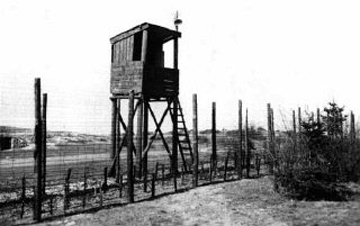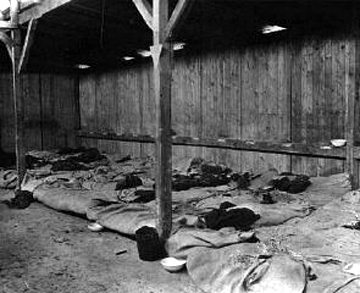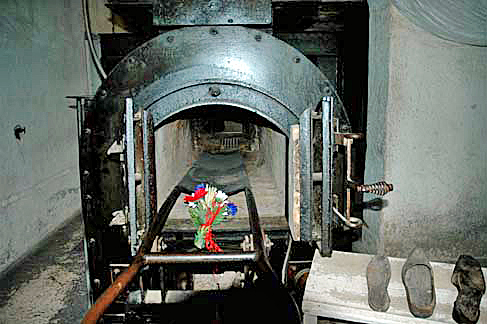Ohrdruf sub-camp of BuchenwaldPrevious The photo above shows what the Ohrdruf sub-camp of Buchenwald looked like when it was discovered by Americn troops on April 4, 1945. The whole camp has since been torn down and there is no trace of it left. There is no Memorial Site at Ohrdruf for the prisoners who lost their lives in this horrible place. On the left in the photo below is a wooden guard tower. Another guard tower is shown in the photo above.  The camp was enclosed by two barbed wire fences a few feet apart, just like the Natzweiler camp which was discovered by American soldiers in September 1944. The barracks were built of wood and painted green. The photo below, which shows the inside of one of the barracks, was taken on April 13, 1945.  Captain Alois Liethen, who was one of the first American soldiers to see the camp, wrote the following to his family in a letter dated April 13, 1945: The quarters which they had were about as bad as I have ever seen. In a building about 100 x 30 there were from 200 to 250 men and their bunks were less than two by two by six -- just like pigeon holes along the whole wall. I didn't even go into these buildings because of the fact that there were definite signs of infestations of typhus bearing lice as well as many other communicable diseases. Batheing (sic) facilities were just non-existent, but that is not the worst of it -- when a man was killed or died of beatings he was simply stripped of his clothes and these were reissued immediately to some other living cadaver. Shoes were out of the question and all of the footwear was a wooden sandal -- not even so much as a whole wooden shoe. In the photo above, the bunks have been removed. Most of the prisoners had been evacuated and the camp was in the process of closing when it was discovered by American troops. Captain Liethen implies in his letter that the clothes were not disinfected with Zyklon-B, as in all the other Nazi camps, to kill the lice which spread typhus. This would have caused typhus to spread very quickly. With no showers or wash basins, such as were customary in all the other camps, it would have been very difficult to stop an epidemic of typhus. This could account for the estimated 3,200 deaths in the camp in only a few months. Captain Liethen's letter continues as follows: As long as I am writing a horror tale I might as well describe some of the people who were in charge of this camp. The commandant (a man whose name I knew bak (sic) in the states and who I am looking for now more than ever was an SS Hauptsturmführer BRAULING, and his right hand man was another SS man by the name of STIBITZ. Their favorite pasttime together with one or two other camp officials was to go out to the burning pit with a bottle of whisky each where they would sit and watch the burning of the weeks accumlation (sic) of dead bodies while they joked and drank their whiskey. Personally, the stench of the pit was enough to drive me nuts and a bottle of whiskey might have been a good thing for me while I was there. I have smelled a lot of foul odors -- like out at the rendering works and other places -- but this one was the worst. Evidently they were in such a hurry that they didn't get enough tar and wood on the last pyre for there were about fifty half burned cadavers lying there in chars. As I have stqted (sic) this is not the first one I have sen (sic) -- I saw another which was a more or less refined version of a concentration camp -- this one was in the vicinity of Metz. Here, that is in the one near Metz, were kept the pure political prisoners and they had better conditions and the crematory was a fancy thing, not unlike a bake oven which they showed in a series of pictures in LIFE some time ago. At this one I was mildly surprised and I don't think that I even mentioned having seen it -- this latter one tho is really getting into the real thing. And, when one considers that this place was just a branch unit of a bigger one, well, then you can well imagine what the larger ones are like. The camp near Metz, which Captain Liethen referred to in his letter, was Natzweiler-Struthof in Alsace, which was discovered by American soldiers in September 1944 after it had been abandoned. A photo of the "fancy" crematory at Natzweiler, taken in October 2004, is shown below. The Ohrdruf camp did not have an oven like this one, since it was a temporary camp used to house prisoners while they were working on a building project.  Captain Liethen was an intelligence officer who was at Ohrdruf to investigate the camp for the US military. He had apparently already investigated some of the concentration camps while still in the United States before he went overseas on June 10, 1944. In his letter to his family, he mentioned the names of the Commandant of Ohrdruf and his assistant, two men that he was already familiar with and was looking for. Captain Liethen served as an interrogator for captured Germans who were being screened for potential war crimes trials. As far as I know, the administrators of the Ohrdruf camp were never brought to justice. The letter which Captain Liethen wrote to his family continues as follows: One of the men with whom I spoke had been in a camp in Poland where he knew that there were over 3000000 gassed and then burned. Yes I mean 3 Millions of people. Why? Well, I questioned all of the inmates of this camp as well as a lot of others who had escaped thru our lines and here are the real reasons: Some were thrown in because they were Jews, they were the ones that had the least chance of survival; Some were thrown in because they were half Jews, their chances were no better -- and this made up the greatest number of the inmates; Some were people who, from Poland, France, Germany, Holland, Belgium, Luxembourg, Russia, and all of the other over run countries refused to swear allegiance (sic) to the Nazi government. Once you were in the clutches of the Gestapo the odds were 99 out of a hundred that you wound up in a place like this. One bit of evidence that I have which I will keep to show you even tho I have been offered fabulous prices for it is a piece of gold, pure gold weighing about 5 ounces, which I found in the pockets of a prisoner who had been a guard in this camp near Metz. This will verify Life magazine insofar that this gold was derived from the teeth which were knocked out of the mouths of the corpses prior to their incineration in this fancy oven. I have other stories that I will have to check on later on as we over take these concentration camps. The camp where the Polish prisoner said that 3 million people were gassed is Auschwitz. When Auschwitz was evacuated on January 18, 1945, the prisoners were marched back to Germany and put on trains to Buchenwald and other camps. Some of these prisoners were assigned to Ohrdruf. When Ohrdruf was evacuated, the prisoners were marched back to Buchenwald and then put on trains to Dachau and Theresienstadt. In America, the Japanese-Americans who would not "swear allegiance" to our government were sent to a federal prison where they were forced to work at hard labor. These were the so-called "No-No boys" who answered No when asked if they would swear allegiance to the United States, and No when asked if they would serve in the US Army. The prisoners at Natzweiler and Buchenwald, who were sent there by the Gestapo from countries occupied by Germany, were Resistance fighters or insurgents who were blowing up troop trains and factories. Like Eisenhower, who used the term "internment camp" when referring to Ohrdruf, Captain Liethen compared the reason for imprisonment of the Ohrdruf prisoners to the reason for the incarceration of Japanese-Americans in American camps. Today the grounds of the former Ohrdruf-Nord concentration camp are located in a German Army Training Center. To arrange a visit to the site of the former camp, one may write to the following address: Bundeswehr PreviousBuchenwald main campHomeThis page was last updated on November 16, 2008 |